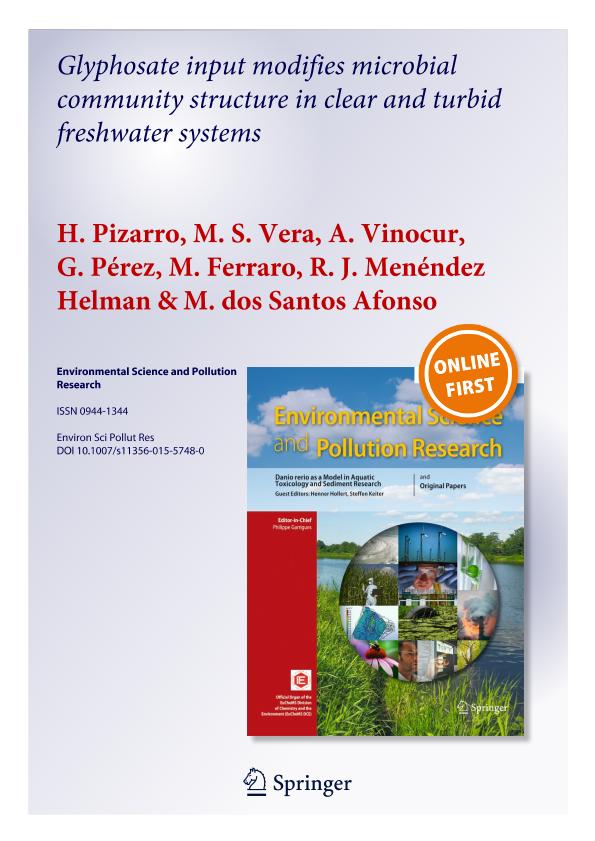Artículo
Glyphosate input modifies microbial community structure in clear and turbid freshwater systems
Pizarro, Haydee Norma ; Vera, Maria Solange
; Vera, Maria Solange ; Vinocur, A.; Pérez, Gonzalo
; Vinocur, A.; Pérez, Gonzalo ; Ferraro, M.; Menendez Helman, Renata Julia
; Ferraro, M.; Menendez Helman, Renata Julia ; Dos Santos Afonso, María
; Dos Santos Afonso, María
 ; Vera, Maria Solange
; Vera, Maria Solange ; Vinocur, A.; Pérez, Gonzalo
; Vinocur, A.; Pérez, Gonzalo ; Ferraro, M.; Menendez Helman, Renata Julia
; Ferraro, M.; Menendez Helman, Renata Julia ; Dos Santos Afonso, María
; Dos Santos Afonso, María
Fecha de publicación:
03/2016
Editorial:
Springer Heidelberg
Revista:
Environmental Science and Pollution Research
ISSN:
0944-1344
Idioma:
Inglés
Tipo de recurso:
Artículo publicado
Clasificación temática:
Resumen
Since it was commercially introduced in 1974, glyphosate has been one of the most commonly used herbicides in agriculture worldwide, and there is growing concern about its adverse effects on the environment. Assuming that glyphosate may increase the organic turbidity of water bodies, we evaluated the effect of a single application of 2.4 ± 0.1 mg l−1 of glyphosate (technical grade) on freshwater bacterioplankton and phytoplankton (pico, micro, and nanophytoplankton) and on the physical and chemical properties of the water. We used outdoor experimental mesocosms under clear and oligotrophic (phytoplanktonic chlorophyll a = 2.04 μg l−1; turbidity = 2.0 NTU) and organic turbid and eutrophic (phytoplanktonic chlorophyll a = 50.3 μg l−1; turbidity = 16.0 NTU) scenarios. Samplings were conducted at the beginning of the experiment and at 1, 8, 19, and 33 days after glyphosate addition. For both typologies, the herbicide affected the abiotic water properties (with a marked increase in total phosphorus), but it did not affect the structure of micro and nanophytoplankton. In clear waters, glyphosate treatment induced a trend toward higher bacteria and picoeukaryotes abundances, while there was a 2 to 2.5-fold increase in picocyanobacteria number. In turbid waters, without picoeukaryotes at the beginning of the experiment, glyphosate decreased bacteria abundance but increased the number of picocyanobacteria, suggesting a direct favorable effect. Moreover, our results show that the impact of the herbicide was observed in microorganisms from both oligo and eutrophic conditions, indicating that the impact would be independent of the trophic status of the water body.
Archivos asociados
Licencia
Identificadores
Colecciones
Articulos(IEGEBA)
Articulos de INSTITUTO DE ECOLOGIA, GENETICA Y EVOLUCION DE BS. AS
Articulos de INSTITUTO DE ECOLOGIA, GENETICA Y EVOLUCION DE BS. AS
Citación
Pizarro, Haydee Norma; Vera, Maria Solange; Vinocur, A.; Pérez, Gonzalo; Ferraro, M.; et al.; Glyphosate input modifies microbial community structure in clear and turbid freshwater systems; Springer Heidelberg; Environmental Science and Pollution Research; 23; 6; 3-2016; 5143-5153
Compartir
Altmétricas



